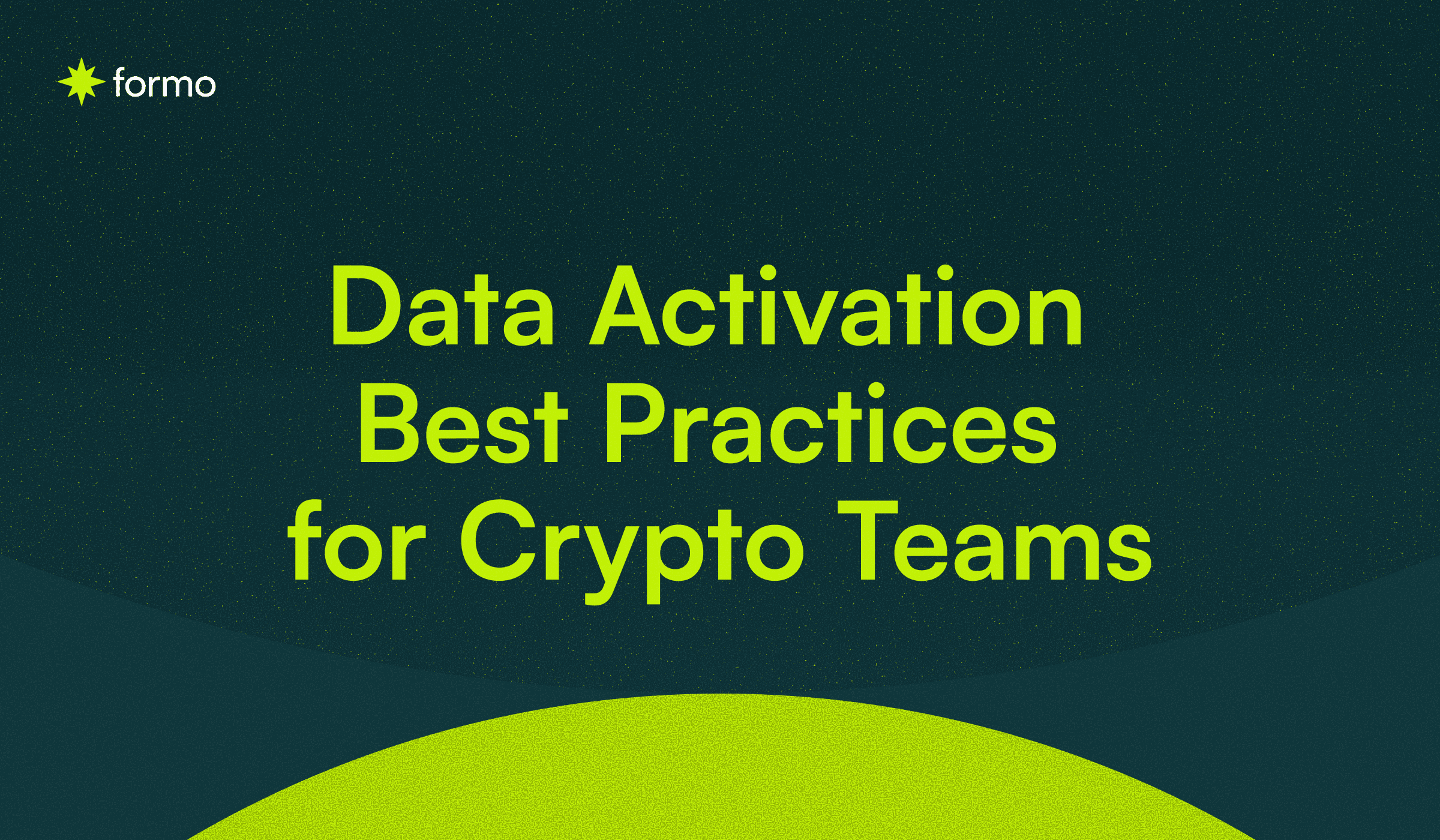Clickstream Data: Powering Onchain & Web3 Analytics
Building a successful web3 app without understanding user behavior is like navigating in the dark. You might feel like you're moving, but the path is unclear. Clickstream data is the light that illuminates the path to growth, showing you exactly how users interact with your decentralized application (dApp) from their first offchain visit to their final onchain transaction.
Clickstream data is the detailed record of every user interaction, creating a digital breadcrumb of a user's journey. For crypto product and marketing teams, this data is invaluable. It bridges the gap between offchain marketing activities and onchain user behavior, offering a unified view that is critical for driving product adoption, retention, and sustainable growth.
This post will explain what clickstream data is, why it's essential for onchain analytics, and how you can implement onchain data collection to make smarter, data-driven decisions. By the end, you'll understand how to leverage this data to turn insights into action.
What is Clickstream Data?
Clickstream data is a comprehensive record of a user's journey and interactions on a website or app. It captures every click, page view, transaction, and action, providing a granular look at how users engage with your product.
In the context of crypto analytics, its scope expands significantly. It doesn't just track offchain website engagement; it extends to onchain activities like wallet connections, smart contract interactions, and token swaps. This allows teams building in web3 to get a complete, unified view of onchain user behavior, linking anonymous wallet addresses to tangible actions and business impact.
Types and Examples of Clickstream Data
To truly understand your users, you need to capture a variety of data points. Clickstream data encompasses several categories, each offering unique insights into how users engage with your dApp and DeFi protocols.
Web Navigation Data
This data helps you understand how users move through your website, revealing the paths that lead to conversion or cause them to drop off.
Entry Points: The first page a visitor views.
URLs Visited: The sequence of pages a user navigates during a session.
Referrer URL: The source that directed the user to your site (e.g., Twitter, Google).
Exit Points: The last page a user sees before leaving.
User Interaction Data
This category highlights how users engage with specific elements on your site, enabling you to optimize the user experience.
Scroll Depth: How far a user scrolls down a page.
Button Clicks: Interactions with calls-to-action like "Connect Wallet" or "Stake Now."
Form Interactions: Data on fields completed or abandoned in forms.
Element Interactions: Engagement with videos, carousels, or other dynamic content.
Temporal Data
Timing is everything. Temporal data tracks the sequence and duration of user actions, which is crucial for optimizing user journeys.
Timestamps: The exact time an action or click event occurred.
Session Duration: The total time a user spends on your site in a single visit.
Page Load Times: The time it takes for pages to render, impacting user experience.
Conversion Data
Conversion data tracks the key actions that signify a win for your organization.
Signups: New account or product registrations.
Transactions: Completed onchain swaps, purchases, or other value exchanges.
Checkout Completions: Finalization of a purchase process.
Session Data
This data aggregates a user's activities within a single visit, offering a holistic view of their engagement.
Number of Pages Viewed: The total number of pages navigated in one session.
Session Start and End Times: Timestamps marking the beginning and end of a session.
Session Interactions: All clicks, searches, and other actions recorded during a visit.
Error Data
Technical glitches can kill the user experience. Error data helps you identify and fix these issues quickly.
404 Errors: Instances where a user lands on a non-existent page.
Validation Errors: Failed form submissions due to incorrect data.
Timeout Errors: Delays caused by server or network issues.
Search Data
On-site search queries offer a direct window into user intent.
Search Queries: The terms users input into your site's search bar.
Search Result Clicks: Which search results users engage with.
Onchain Data
This is where clickstream data becomes uniquely powerful for web3. Onchain data provides invaluable insights into key touchpoints of the user's journey.
Wallet Data: Details about a user's wallet, including metadata and transaction history.
Smart Contract Interactions: Information on how users interact with your deployed contracts (e.g., staking, swapping).
Wallet Activity: Tracking wallet-specific actions like deposits and withdrawals.
DeFi Positions: Analysis of a user's DeFi holdings and vault interactions.
By capturing these varied types of clickstream data, teams building onchain can effectively map user journeys, optimize product performance, and implement growth strategies that resonate with a web3 audience.
Use Cases of Clickstream Data for Web3
Clickstream data isn't just about collecting information; it's about applying it to solve real-world challenges. For crypto and onchain apps, the applications are transformative.
Full-Funnel User Journey Mapping
Track a user from their very first touchpoint—whether a Twitter campaign or an organic search—all the way to their first onchain transaction. Platforms like Formo can unify this entire journey, attributing onchain conversions directly to the offchain marketing efforts that drove them. This finally provides a clear measure of marketing ROI in web3.
Granular User Behavior Insights
Understand exactly how users interact with your dApp and protocols. By tracking onchain user behavior, you can identify which features are most popular, where users get stuck, or why they might abandon a process before completing a swap. These granular insights are essential for prioritizing your product roadmap.
Conversion & Retention Optimization
Analyzing clickstream data through funnels reveals exactly where users drop off. For example, if you notice many users connect their wallet but don't proceed to staking, you can investigate the friction point. Is the UI confusing? Are the gas fees too high? Tools with cohort and funnel analytics help you diagnose these issues and refine your product to improve retention.
Building a Customer 360 View
Unifying offchain and onchain data creates rich, actionable wallet profiles. This allows for advanced user segmentation. You can group users based on their transaction history, token holdings, or engagement levels to deliver personalized in-app experiences and highly targeted marketing campaigns. Formo’s Wallet Intelligence feature is designed specifically for this purpose.
Enhanced Security and Performance
Error data collection is critical for maintaining a seamless user experience. By quickly identifying 404 errors, transaction failures, or other technical glitches, your team can fix issues before they impact a larger user base.
Event Tracking Use Cases in Crypto
At its core, clickstream data collection relies on event tracking. Each user action is an "event," and tracking these events unlocks powerful use cases.
Audience Targeting: Refine marketing campaigns by retargeting users based on specific behaviors. For example, you can create a segment of users who started a swap but didn't complete it and target them with a reminder.
Personalization: Deliver tailored in-app experiences. A DeFi protocol could recommend new liquidity pools based on a user's past staking activity.
Analytics: Gain deep insights into user actions to identify bottlenecks. If a specific user cohort is struggling with onboarding, you can analyze their journey to understand why and optimize the process.
Attribution: Pinpoint where your most valuable users are coming from. By linking sign-ups or transactions to UTM parameters, you can measure the ROI of each marketing channel, from paid ads to organic search.
Experimentation: Use event data to run A/B tests. Test different versions of your dApp's interface or messaging to see which one drives higher conversion rates or better engagement.
Lifecycle Marketing Automation: Trigger automated workflows based on user actions. Send onboarding tips to new users, or re-engagement campaigns to those who have become inactive.
Cross-Chain User Insights: For protocols on multiple EVM-compatible blockchains, event tracking provides a holistic view of how users move between chains, supporting better onboarding and product optimization.
Fraud Detection: Monitor for unusual patterns in transaction activity or onchain interactions to quickly identify potential security threats and protect user assets.
How is Clickstream Data Collected?
The primary method for modern web3 data collection is through Software Development Kits (SDKs) and web3 customer data platforms.
SDKs are code snippets that you embed into your dApp. Once installed, they can automatically capture key events like page views, wallet connects, signatures, and transactions. This simplifies the setup for web3 event tracking, as you don't have to manually tag every single action. Platforms like Formo offer "autocapture" capabilities, making the initial data collection process much easier.
These SDKs are often available across multiple platforms (web, mobile) and tech stacks (React, Next.js, etc.). For more custom or complex onchain data collection scenarios, APIs and server-side calls can also be used to send event data directly.
Tools for Clickstream Data Collection & Analysis
Several tools can help you collect and analyze clickstream data, but not all are built for the unique challenges of web3.
Formo: This is a data platform built specifically for onchain apps. It unifies web, product, and onchain analytics into a single view. Key features include wallet intelligence, onchain attribution, and self-serve analytics dashboards that empower the whole team. Its open-source SDKs also provide transparency and flexibility.
RudderStack: A powerful Customer Data Platform (CDP) that can collect and route event data to various destinations, including data warehouses.
Segment: Another popular CDP that excels at collecting event data and dispatching it to other applications.
While tools like RudderStack and Segment are powerful, they are general-purpose platforms. They often require significant configuration to handle the specifics of onchain event tracking, wallet identity resolution, and cross-chain analysis. Formo, on the other hand, is designed from the ground up for web3 teams.
Formo’s SDK includes autocapture functionality, enabling teams to automatically track essential events like page views, wallet connects, signatures, and transactions without extensive manual configuration. This simplifies the setup process for web3 projects, allowing teams to focus on growth and insights rather than complex event tracking.
For more customized onchain data collection scenarios, Formo also offers flexible APIs and server-side call capabilities, providing the tools needed to integrate advanced and highly tailored event tracking seamlessly into your workflow.
Unlock Your Onchain Growth
Clickstream data is no longer a "nice-to-have"; it is an essential tool for any serious onchain project. It provides the critical insights needed to optimize the user experience, drive conversions, and achieve sustainable growth in a competitive market. By bridging the gap between offchain marketing efforts and onchain results, it delivers a true measure of ROI.
Stop building in the dark. It's time to illuminate your path with data. Get started.
Read more:
Web3 Funnel Analytics: Optimize Your User Journeys for Growth
Web3 Cohort Analysis 101: What it is and real-world examples
Follow Formo on LinkedIn and Twitter, and join our community for more onchain growth insights.
Frequently Asked Questions
What’s the difference between clickstream data and regular web analytics?
Regular web analytics, like those from Google Analytics, primarily focus on offchain metrics like page views and bounce rates. Clickstream data for web3 goes deeper by unifying that offchain data with onchain activities, such as wallet connections, smart contract interactions, and transactions, to provide a complete user journey.
How does clickstream data handle user privacy in crypto?
Privacy is paramount. Leading tools like Formo are built with privacy in mind, avoiding third-party cookies, fingerprinting, and other invasive tracking methods. Onchain data is pseudonymous by nature (tied to a wallet address), and these platforms help you analyze that data without compromising user identity.
Can I track events from any blockchain with these tools?
Most modern web3 analytics platforms support all EVM-compatible blockchains. This allows you to track user behavior across chains like Ethereum, Polygon, Base, and others, providing valuable cross-chain insights.
How much technical expertise is needed to set up web3 event tracking?
With modern tools, the initial setup is straightforward. Installing an SDK often involves just a few lines of code. Many platforms also offer "autocapture" features that automatically track standard events, reducing the need for extensive engineering resources to get started.
What are the first three events I should track for my DeFi app?
Wallet Connect: This is the first key step a user takes to engage with your dApp.
A Core Action (e.g., Swap or Stake): Track the primary action or transaction you want users to take.
Transaction Submitted: This confirms the user has completed an onchain action.
How can clickstream data help me reduce customer acquisition cost (CAC)?
By providing clear onchain attribution, clickstream data shows you which marketing channels are driving actual conversions, not just traffic. Based on key metrics such as CAC, you can then reallocate your budget to the most effective channels, lowering your cost to acquire new customers.
Can Formo integrate with other tools in my stack?
Yes, platforms like Formo are designed to be part of a modern data stack. They can route data to warehouses like BigQuery or Snowflake or connect to business intelligence tools like Hex and Superset. Formo can integrate with marketing tools to enable automated, data-driven campaigns.
How is onchain data collection different from just using a block explorer like Etherscan?
Block explorers show raw, isolated transaction data without any context on who or what happened. Onchain analytics platforms like Formo contextualize this data by linking it to offchain user behavior. This allows you to see the full journey—from a user clicking a marketing link to executing a transaction—which is impossible to see with a block explorer alone.





